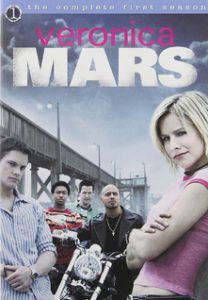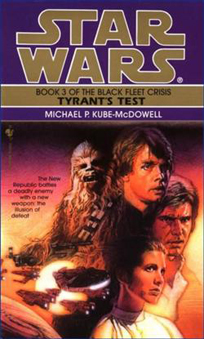The final installment in Michael P. Kube-McDowell’s “Black Fleet Crisis” trilogy, “Tyrant’s Test” (1997), achieves a curious combination. Like the first two books, it’s quite readable, and I’d venture to say it’s unfairly lumped in with the bad Bantam novels of the 1990s. On the other hand, not much of significance – or of relevance to future yarns — happens in the book. And that’s why I didn’t remember the details of this trilogy from my first read.
There are exceptions that I’ll get to in a moment, but the most egregious example of “Well, that was a lot of words for not much payoff” is Lando’s “Rendezvous with Rama”-style sci-fi plot. In the end, we learn that the vagabond is a vessel to re-seed the planet Qella, which had experienced an ice age when one of its moons crashed into the surface. The story ultimately has no impact on Lando’s character or the “Star Wars” universe in general. The timing doesn’t make sense, either, as it seems several weeks have passed in the galaxy at large yet Lando and Lobot don’t die of thirst or starvation considering that they started with minimal supplies.
Luke’s search for his mother also has a muted payoff. As was kind of obvious all along, Akanah was lying to Luke when she said she had a lead on tracking down his mother, “Nashira.” What’s weird is that she basically just tricked Luke so she’d have some help with tracking down and reuniting with her people, the Fallanassi. Along the way, she tries to impart some Fallanassi teachings on Luke (they are Force users who never accept violence as an answer), but then rejects him when he shows serious interest on the principle that they are a secretive sect. At least the Fallanassi will play a role in future yarns, notably the “New Jedi Order.”
The meatiest part of “Tyrant’s Test” is the New Republic vs. Yevetha war, and the way the conflict challenges New Republic president Leia and allows for a coming-of-age yarn for Chewbacca’s son, Lumpawarrump. In a twist that was fairly novel for “Star Wars” yarns back in 1997, Leia is in the hero’s role while Han is in the traditional damsel in distress role, having been captured and beaten by Yevetha warlord Nil Spaar.
As I noted in my previous “Black Fleet Crisis” reviews, McDowell presents a simplified foundation for a debate over military interventionism. Spaar remains the embodiment of evil, and the same goes for his people. Furthermore, the book includes absolutely no mention of the fiscal status of the New Republic. Does it have a balanced budget, or is it trillions of credits in debt? That said, “Tyrant’s Test” provides food for thought over whether the New Republic has a duty to punish the Yevetha for their genocides of non-Yevetha planets in the Koornacht Cluster. War will not bring back the dead, and it will certainly lead to additional deaths, yet Leia does provide a compelling argument that holding the Yevetha accountable is the moral thing to do.

Interestingly, Leia even discounts the prospect of Yevetha expansionism in her push for war on page 244:
“The prospect that they might next fall on Wehttam or Galantos or another more familiar world is unnecessary to our response. … If we cannot stand together against such a predator, the New Republic stands for nothing of value.”
I found it amusing that during Leia’s speech, the Senate chamber is packed to the rafters with engaged, cheering members of the citizenry. While the “Star Wars” Expanded Universe has plenty of examples of citizens who want nothing to do with politics, it generally tends to portray politics and galactic welfare as being more central to the average person’s life than, say, sports and entertainment. People like Leia, Luke and Han aren’t just war heroes and – in the case of Leia – a politician, they are themselves celebrities on par with Earth’s pop stars. And this phenomenon is not central to Coruscant (the GFFA’s equivalent of Washington, D.C.). Luke uses the Force to disguise himself as “Li Stonn” throughout his galactic travels in this trilogy, only dropping the façade when he’s among the fleet – and even there, the members of the military fawn over him.
One oddity of the Yevetha conflict is that the Jedi Order doesn’t get involved at all. (A Fallanassi ends up helping out, but that’s largely by accident.) I have to ask what Luke’s Jedi Academy (largely – if not entirely — funded by taxpayers) is there for if not to help out in conflicts such as this. Yes, it’s true that their three-year involvement as Republic generals in the Clone Wars crossed the line from “guardians of peace and justice” to full-time warriors. And I wouldn’t necessarily argue that Luke’s Jedi students should be legally compelled to fight the Yevetha.
But the fact that not a single one of them volunteers to help is frankly rather pathetic. McDowell pays lip service to the question of the Jedi’s role in the New Republic, but misses a chance for deeper exploration. He writes about a lot of grunts in the armed forces, and those pages might’ve been better spent on a Jedi from Luke’s academy joining the Navy and wrestling with his principles of peace. From this trilogy, I have to conclude that the Jedi are a religious order that receives state funding, and I would’ve hoped that went against the Republic’s founding principles.
I didn’t particularly enjoy the space battles or military strategy in “Tyrant’s Test,” but McDowell knows his strengths and weaknesses and doesn’t devote too many words to them. The Lando arc is wildly overwritten, but the “Black Fleet Crisis” does deliver good Leia characterization, intriguing meditations on the morality of how Jedi should use the Force, and the only notable character growth for Chewie’s son you’ll find anywhere. It’s not essential reading, but fans who’ve tackled the must-reads such as Zahn, Stackpole and Traviss and are looking to delve into the next level of decent yarns should find quite a bit to enjoy about McDowell’s trilogy.

